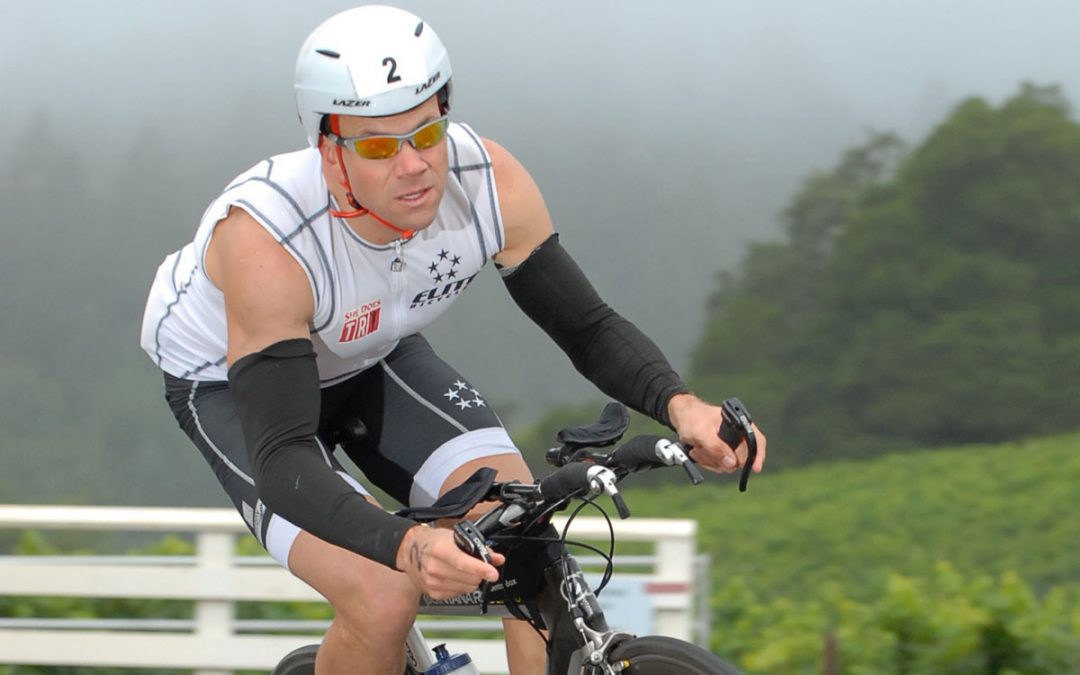A triathlete emailed me the following question about his upcoming IRONMAN® race:
I’m concerned about the expected weather temperature on race day: high of 68 and low of 48. It will be fine during the day but very cold on the start of the bike and could be exceptionally cold in the evening. Any suggestions on clothing?
This is an important question as being comfortable during the race – whether it’s riding with a comfortable bike fit or staying warm – is a key factor for success, especially in longer races like a 70.3 or IRONMAN. There is a tradeoff, however, with losing time if you’re changing clothes at each transition or during the race when accessing a special needs bag.
Let me share an example of what worked for me. IRONMAN Vineman, which is a race I’ve done multiple times, has temperatures that are typically in the 40’s to 50’s F in the morning at the swim start in the Russian River where a thick blanket of fog blocks the sun. Temperatures quickly warm up about halfway through the bike course and would reach high 70’s to 80’s F during the day before cooling down again at night.
For the swim, water temperatures were typically in the low to moderately hgih 70’s F so wetsuit legal in every Vineman race that I did. I always wore a wetsuit (if permitted) for the buoyancy. If water temperatures were less than 72F +/- then I wore a full sleeve suit; otherwise, I wore a sleeveless so I wouldn’t overheat.
I wanted to be warm at the start of the bike but not have to change clothing during transitions. I wore my kit (tri top and shorts) under my wetsuit, toweled off quickly during swim to bike transition, then put on dry arm warmers on the bike. Once air temps warmed up sufficiently, I rolled the arm warmers down to my wrist. During the bike to run, I pulled off my arm warmers then put on a visor to protect from face the sun while allowing heat to escape from my head.
I finished during the heat of the day so didn’t have to worry about cooler temperatures at night. If I had expected to finish after sundown, I would have put an old longsleeve shirt in either my bike to run transition bag and/or special needs bag. I would then have the option of putting on the shirt or not.
For races that start out very cold, it may be worth changing into dry clothes at the start of the bike. Layers that you can peel off work best as temperatures warm up. At the inaugural Mohican Pineman (IRONMAN distance) in 2001, I made the mistake of not changing into dry clothes for a race that was cold and overcast all day. Although I saved 60 seconds in transition, I stayed chilled, which negatively affected my bike split and ultimately cost me many minutes of time and lots of discomfort.
When in doubt, I suggest racing in clothing that keeps you comfortable, especially in the longer races.
Good luck and happy racing,
David
—
About the Author:
Coach David B. Glover, MS, CSCS has completed 28 IRONMAN distance triathlons including two sub 9 hour finishes and winning Vineman Full twice. Now, David’s passion now is helping triathlete and other endurance athletes achieve their dreams through his online triathlon education and training company, ENDURANCEWORKS. David has an MS in Exercise Physiology and is certified as a coach by USA Triathlon and USA Cycling as well as having his CSCS from NSCA. After six years of living, training and coaching in the triathlon mecca of Boulder, CO, David currently resides in Southern California.


